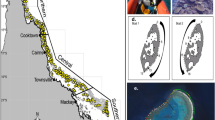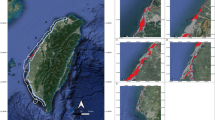Abstract
Seagrass beds are subject to numerous anthropogenic influences, including nutrient pollution, shoreline development and modification, and overfishing. Direct human impacts on seagrass though, such as through contact with boat propellers and fishing gear, remains relatively uninvestigated. Here, we use 26 years of aerial imagery and 3 years of ground surveys to explore the degree, distribution, and recovery of scarring in seagrass beds as the result of boat propellers in lower Chesapeake Bay, USA, specifically from commercial haul seine fishing activity. We find that propeller scarring is extensive, particularly on the western shore of the Bay, where pressure from haul seining is more intense. In two areas with the most intense scarring, Browns Bay and Poquoson Flats, annual total length of scars averaged 5575 and 3206 m, respectively. Despite the considerable presence of observable scarring, an individual scar generally persisted for only 2.7 years on average, implying quick recovery, aided by the diverse reproductive habits of the two seagrasses in this region, Zostera marina and Ruppia maritima. Moreover, regulations adopted by the regulary agency responsible for protecting marine habitats in Chesapeake Bay, the Virginia Marine Resources Commission, concerning the timing of haul seining in response to these findings reduced the frequency of new scars 43% at Browns Bay and 90% at Poquoson Flats since 2003. These results demonstrate that swift and decisive management action, in cooperation with relevant science, can lead to effective conservation of underwater grasses.






Similar content being viewed by others
References
Ailstock, M.S., D.J. Shafer, and A.D. Magoun. 2010. Effects of planting depth, sediment grain size, and nutrients on Ruppia maritima and Potamogeton perfoliatus seedling emergence and growth. Restoration Ecology 18: 574–583.
Alexandre, A., R. Santos, and E. Serrao. 2005. Effects of clam harvesting on sexual reproduction of the seagrass Zostera noltii. Marine Ecology Progress Series 298: 115–122.
Barbier, E.B., S.D. Hacker, C. Kennedy, E.W. Koch, A.C. Stier, and B.R. Silliman. 2011. The value of estuarine and coastal ecosystem services. Ecological Monographs 81: 169–193.
Bell, S.S., M.O. Hall, S. Soffian, and K. Madley. 2002. Assessing the impact of boat propeller scars on fish and shrimp utilizing seagrass beds. Ecological Applications 12: 206–217.
Burfeind, D.D., and G.W. Stunz. 2006. The effects of boat propeller scarring intensity on nekton abundance in subtropical seagrass beds. Marine Biology 148: 953–962.
Cabaco, S., A. Alexandre, and R. Santos. 2005. Population-level effects of clam harvesting on the seagrass Zostera noltii. Marine Ecology Progress Series 298: 115–122.
Costanza, R., R. d’Arge, R. de Groot, S. Farber, M. Grasso, B. Hannon, K. Limburg, S. Naeem, R.V. O’Neill, J. Paruelo, R.G. Raskin, P. Rutton, and M. van den Belt. 1997. The value of the world’s ecosystem services and natural capital. Nature 387: 253–260.
Dawes, C.J., J. Andorfer, C. Rose, C. Uranowski, and N. Ehringer. 1997. Regrowth of the seagrass Thalassia testudinum into propeller scars. Aquatic Botany 59: 139–176.
De Jonge, V.N. and D.J. De Jong. 1992. Role of tide, light, and fisheries in the decline of Zostera marina L. in the Dutch Wadden Sea. Netherlands Institute for Sea Research, Publication Series No. 20, 161–176.
Dobson, J.E., E.A. Bright, R.L. Ferguson, D.W. Field, L.L. Wood, K.D. Haddad, H. Iredale, III, J.R. Jensen, V.V. Klemas, R.J. Orth, and J.P. Thomas. 1995. NOAA Coastal change analysis program (C-CAP): guidance for regional implementation. NOAA Tech. Rep. NMFS 123. 92 pp.
Duarte, C.M. 2003. The future of seagrass meadows. Environmental Conservation 29: 192–206.
Duarte, C.M., J.W. Fourqurean, D. Krause-Jensen, and B. Olesen. 2006. Dynamics of seagrass stability and change. In Seagrasses: biology, ecology and conservation, ed. A.W.D. Larkum, R.J. Orth, and C.M. Duarte, 111–133. The Netherlands: Springer.
Dunton, K.H., and S.V. Schonberg. 2002. Assessment of propeller scarring in seagrass beds on the south Texas Coast. Journal of Coastal Research SI 37: 100–110.
Fonseca, M.S., G.W. Thayer, and A.J. Chester. 1984. Impact of scallop harvesting on eelgrass (Zostera marina) meadows: Implications for management. North American Journal of Fisheries Management 4: 286–293.
Gonzalez-Correa, J.M., J.T. Bayle, J.L. Sanchez-Lizaso, C. Valle, P. Sanchez-Jerez, and J.M. Tuiz. 2005. Recovery of deep Posidonia oceanica meadows degraded by trawling. Journal of Experimental Marine Biology and Ecology 320: 65–76.
Guillén, J.E., A.A. Ramos, L. Martinez, and J.L. Sanchez Lizaso. 1994. Anti-trawling reefs and the protection of Posidonia oceanica (L.) Delile meadows in the western Mediterranean Sea: Demand and aims. Bulletin of Marine Science 55: 645–650.
Hendriks, I.E., S. Tenan, G. Tavecchia, N. Marba, G. Jorda, S. Deudero, E. Alvarez, and C.M. Duarte. 2013. Boat anchoring impacts coastal populations of the pen shell, the largest bivalve in the Mediterranean. Biological Conservation 160: 105–113.
Kemp, W.M., W.R. Boynton, J.E. Adolf, D.F. Boesch, W.C. Boicourt, G. Brush, J.C. Cornwell, T.R. Fisher, P.M. Glibert, J.D. Hagy, L.W. Harding, E.D. Houde, D.G. Kimmel, W.D. Miller, R.I.E. Newell, M.R. Roman, E.M. Smith, and J.C. Stevenson. 2005. Eutrophication of Chesapeake Bay: historical trends and ecological interactions. Marine Ecology Progress Series 303: 1–29.
Lefcheck, J.S., S.R. Marion, A.V. Lombana, and R.J. Orth. 2016. Faunal communities are invariant to fragmentation in experimental seagrass landscapes. PloS One 11 (5): e0156550.
Lefcheck, J.S., D. J. Wilcox, R.R. Murphy, S.R. Marion, and R.J. Orth. 2017. Multiple stressors threaten the imperiled coastal foundation species, eelgrass (Zostera marina) in Chesapeake Bay, USA. Global Change Biololgy. doi:10.1111/gcb.13623.
Martin, S.R., C.P. Onuf, and K.H. Dunton. 2008. Assessment of propeller and off-road vehicle scarring in seagrass beds and wind-tidal flats of the southwestern Gulf of Mexico. Botanica Marina 51: 79–91.
McGlathery, K.J., L.K. Reynolds, L.W. Cole, R.J. Orth, S.R. Marion, and A. Schwarzschild. 2012. Recovery trajectories during state changes from bare sediment to eelgrass dominance. Marine Ecology Progress Series 448: 209–221. doi:10.3354/meps09574.
Milazzo, M., F. Badalamenti, G. Ceccherelli, and R. Chemello. 2004. Boat anchoring on Posidonia oceanica in a marine protected area (Italy, western Mediterranean): effect of anchor types in different anchoring stages. Journal of Experimental Marine Biology and Ecology 299: L51–L62.
Moore, K.A., R.J. Orth, and J.F. Nowak. 1993. Environmental regulation of seed germination in Zostera marina L. (eelgrass) in Chesapeake Bay: Effects of light, oxygen, and sediment burial depth. Aquatic Botany 45: 79–91.
Neckles, H.A., F.T. Short, S. Barker, and B.S. Kopp. 2005. Disturbance of eelgrass, Zostera marina, by commercial mussel Mytilus edulis harvesting in Maine: dredging impacts, and habitat recovery. Marine Ecology Progress Series 285: 57–73.
Onuf, C.P. 1994. Seagrasses, dredging and light in Laguna Madre, Texas, USA. Estuarine Coastal Shelf Science 9: 75–91.
Orth, R.J. and K.A. Moore. 1982. The biology and propagation of Zostera marina, eelgrass, in the Chesapeake Bay, Virginia. Final Report, U.S. EPA Chesapeake Bay Program, Grant No. R805953 and SRAMSOE No. 265, Virginia Institute of Marine Science. l95 pp.
Orth, R.J., and K.A. Moore. 1984. Distribution and abundance of submerged aquatic vegetation in Chesapeake Bay: an historical perspective. Estuaries 7: 531–540.
Orth, R.J., and K.A. Moore. 1988. Distribution of Zostera marina L. and Ruppia maritima L. s.L. along depth gradients in the lower Chesapeake Bay, USA. Aquatic Botany 32: 291–305.
Orth, R.J., J.R. Fishman, A. Tillman, S. Everett, and K.A. Moore. 2001. Boat scarring effects on submerged aquatic vegetation in Virginia (Year 1). Final Report Virginia Marine Resources Commission. 54 pp.
Orth, R.J., J.R. Fishman, D.J. Wilcox, and K.A. Moore. 2002a. Identification and management of fishing gear impacts in a recovering seagrass system in the coastal bays of the Delmarva Peninsula, USA. Journal Coastal Research SI 37: 111–129.
Orth, R.J., R.A. Batiuk, P.W. Bergstrom, and K.A. Moore. 2002b. A perspective on two decades of policies and regulations influencing the protection and restoration of submerged aquatic vegetation in Chesapeake Bay, USA. Bulletin of Marine Science 71: 1391–1403.
Orth, R.J.T., J.B. Carruthers, W.C. Dennison, C.M. Duarte, J.W. Fourqurean, K.L. Heck Jr., A.R. Hughes, G.A. Kendrick, W.J. Kenworthy, S. Olyarnik, F.T. Short, M. Waycott, and S.L. Williams. 2006. A global crisis for seagrass ecosystems. Bioscience 56: 987–996.
Orth, R.J., S.R. Marion, K.A. Moore, and D.J. Wilcox. 2010a. Eelgrass (Zostera marina L.) in the Chesapeake Bay region of mid-Atlantic Coast of the USA: challenges in conservation and restoration. Estuaries and Coasts 33: 139–150. doi:10.1007/s12237-009-9234-0.
Orth, R.J., M.R. Williams, S.R. Marion, D.J. Wilcox, T.J.B. Carruthers, K.A. Moore, W.M. Kemp, W.C. Dennison, N. Rybicki, P. Bergstrom, and R.A. Batiuk. 2010b. Long term trends in submersed aquatic vegetation (SAV) in Chesapeake Bay, USA, related to water quality. Estuaries and Coasts 33: 1144–1163.
Orth, R.J., D.J. Wilcox, J.R. Whiting. A.K. Kenne, L. Nagey, and E.R. Smith. 2015. Distribution of submerged aquatic vegetation in the Chesapeake Bay and tributaries and Chincoteague Bay −2014. Virginia Institute of Marine Science Special Scientific Report Number 158 (http://www.vims.edu/bio/sav/sav14).
Otway, N.M., and G.W. Macbeth. 1999. Physical effects of hauling on seagrass beds. FRDC Project No. 95/149 and 96/286. New South Wales Fisheries Final Report Series No. 15. ISSN 1440–3544. 86 pp.
Patrick, C.J., and D.E. Weller. 2015. Interannual variation in submerged aquatic vegetation and its relationship to water quality in subestuaries of Chesapeake Bay. Marine Ecology Progress Series 537: 121–135.
Peterson, C.H., H.C. Summerson, and S.R. Fegley. 1987. Ecological consequences of mechanical harvesting of clams. Fishery Bulletin 85: 281–298.
Plus, M., J.-M. Deslous-Paoli, and F. Dagault. 2003. Seagrass (Zostera marina L.) bed recolonization after anoxia-induced full mortality. Aquatic Botany 77: 121–134.
R Development Core Team (2016) R: a language and environment for statistical computing. R Foundation for Statistical Computing, Vienna, Austria. https://www.R-project.org/
Ruhl, H.A., and N.B. Rybicki. 2010. Long-term reductions in anthropogenic nutrients link to improvements in Chesapeake Bay habitat. Proceedings of the National Academy of Sciences 107: 16566–16570.
Sánchez-Jerez, P., C. Barberá-Cebrian, and A.A. Ramos-Esplá. 2000. Influence of the structure of Posidonia oceanica meadows modified by bottom trawling on crustacean assemblages: Comparison of amphipods and decapods. Scientia marina. 64: 319–326.
Sargent, F.J., T.J. Leary, D.W. Crewz, and C.R. Kruer. 1995. Scarring of Florida’s seagrasses: assessment and management options. FMRI Technical Report TR-1. Florida Marine Research Institute. St. Petersburg, Florida. 37 p. plus appendices.
Short, F.T., and S. Wyllie-Echeverria. 1996. Natural and human induced disturbance of seagrasses. Environmental Conservation 23: 17–27.
Sobocinski, K.L., R.J. Orth, M.C. Fabrizio, and R.J. Latour. 2013. Historical comparison of fish community structure in Lower Chesapeake Bay seagrass habitats. Estuaries and Coasts 36: 775–794. doi:10.1007/s12237-013-9586-3.
Uhrin, A.V., and J.G. Holmquist. 2003. Effects of propeller scarring on macrofaunal use of the seagrass Thalassia testudinum. Marine Ecology Progress Series 250: 61–70.
Walker, D.I., R.J. Lukatelich, G. Bastyan, and A.J. McComb. 1989. Effect of boat moorings on seagrass beds near Perth, Western Australia. Aquatic Botany 36: 69–77.
Whitfield, P.E., W.J. Kenworthy, M.J. Durako, K.K. Hammerstrom, and M.F. Merello. 2004. Recruitment of Thalassia testidunum seedlings into physically disturbed seagrass beds. Marine Ecology Progress Series 267: 121–131.
Zieman, J.C. 1976. The ecological effects of physical damage from motor boats on turtle grass beds in southern Florida. Aquatic Botany 2: 127–139.
Acknowledgements
We greatly acknowledge the contributions of numerous staff and students who contributed to this project, especially S. Marion, J. Fishman, A. Tillman, E. Smith, K. Moore, C. Holbert, and J. Richardson. Funding was provided by the grants from the Virginia Commercial and Recreational Fishing License Fund, as well as private grants from the Allied-Signal Foundation and the Keith Campbell Foundation for the Environment. This paper is contribution no. 3594 of the Virginia Institute of Marine Science, College of William and Mary.
Author information
Authors and Affiliations
Corresponding author
Additional information
Communicated by Wayne S. Gardner
Rights and permissions
About this article
Cite this article
Orth, R.J., Lefcheck, J.S. & Wilcox, D.J. Boat Propeller Scarring of Seagrass Beds in Lower Chesapeake Bay, USA: Patterns, Causes, Recovery, and Management. Estuaries and Coasts 40, 1666–1676 (2017). https://doi.org/10.1007/s12237-017-0239-9
Received:
Revised:
Accepted:
Published:
Issue Date:
DOI: https://doi.org/10.1007/s12237-017-0239-9




